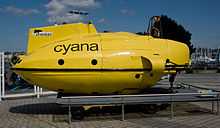IFREMER
| Institut français de recherche pour l'exploitation de la mer | |
|
| |
| Agency overview | |
|---|---|
| Formed | 1984 |
| Preceding agencies |
CNEXO: Centre National pour l'Exploitation des Océans (English: National Centre for the Exploitation of the Oceans) Institut Scientifique et Technique des Pêches Maritimes (English: Scientific and technical institute for marine fisheries) |
| Headquarters | Issy-les-Moulineaux, France |
| Employees | 1,593[1] |
| Annual budget | 213 million euros[1] |
| Agency executive | Jean-Yves Perrot, Président directeur général (CEO) |
| Website | www.ifremer.fr |
The Institut français de recherche pour l'exploitation de la mer (IFREMER, English: French Research Institute for Exploitation of the Sea) is an oceanographic institution in France.
Scope of works
Ifremer focuses its research activities in the following areas:
- Monitoring, use and enhancement of coastal seas
- Monitoring and optimization of aquaculture production
- Fishery resources
- Exploration and exploitation of the oceans and their biodiversity
- Circulation and marine ecosystems, mechanisms, trends and forecasting
- Engineering of major facilities in the service of oceanography
- Knowledge transfer and innovation in its fields of its activities
In 1985, Ifremer partnered with Dr. Robert Ballard for an ultimately-successful expedition to locate the wreck of the RMS Titanic. In 1994 Ifremer assisted in the salvage of the cargo from the SS John Barry.
Ifremer operates a number of vessels, including the submarine Nautile.
In 2008, Ifremer partnered with Dr. Bruce Shillito for the testing and initial operations of the PERISCOP, a deep sea fish recovery device.[2]
Ifremer centres
Ifremer is located in 26 sites, including 5 main centres (Boulogne, Brest, Nantes, Toulon et Tahiti), a headquarters (Issy-les-Moulineaux). About twenty research departments are associated to these centres :


- Centre Manche - Mer du Nord, associated to Université Lille Nord de France[3]
- Centre in Boulogne-sur-Mer
- Station of Port-en-Bessin
- Centre in Brest
- Station of Saint-Malo
- Station of Argenton-en-Landunvez
- Station of Concarneau
- Station of Lorient
- Station of La Trinité-sur-Mer
- Centre in Nantes
- Station of Bouin
- Station of La Rochelle
- Station of La Tremblade
- Station of Arcachon
- Laboratory of Bidart
- Centre Méditerranée (Toulon)
- Station of Sète
- Station of Palavas-les-Flots
- Unit of Montpellier
- Station of San-Giuliano
- Centre in Tahiti
- Délégation de Nouvelle-Calédonie
- Délégation of Guyane
- Délégation of la Réunion
- Délégation of Antilles
See also
![]() Media related to Ifremer at Wikimedia Commons
Media related to Ifremer at Wikimedia Commons
Notes and references
- ↑ 1.0 1.1 Ifremer: Presentation of the Institute
- ↑ Lever, Anna-Marie (31 July 2008). "Live fish caught at record depth". BBC News. Retrieved 18 February 2011.
- ↑ French Décret n°2009-33 about Université Lille Nord de France
External links

| ||||||||||||||



